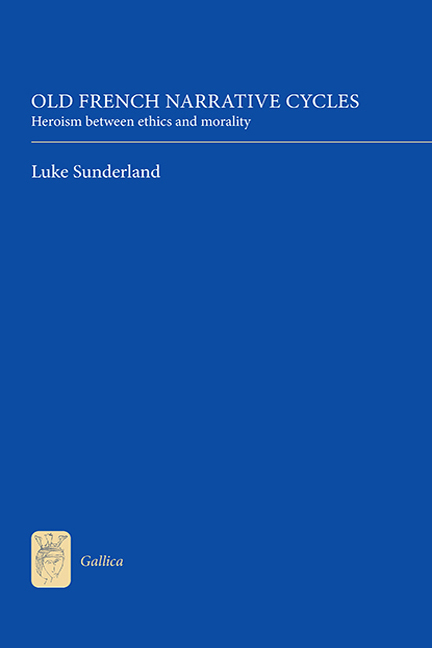Book contents
- Frontmatter
- Contents
- Dedication
- Acknowledgments
- Manuscripts of the Cycle de Guillaume
- Manuscripts of the Roman de Renart
- References and Abbreviations
- Introduction
- 1 Duty to the Geste: The Cycle de Guillaume d'Orange
- 2 Metaphor, Metonymy and Morality: The Vulgate Cycle
- 3 Responsibility to Reputation: The Prose Tristan
- 4 Ethical Evil: The Roman de Renart
- Conclusion
- Bibliography
- Index
- Miscellaneous EndMatter
- Frontmatter
- Contents
- Dedication
- Acknowledgments
- Manuscripts of the Cycle de Guillaume
- Manuscripts of the Roman de Renart
- References and Abbreviations
- Introduction
- 1 Duty to the Geste: The Cycle de Guillaume d'Orange
- 2 Metaphor, Metonymy and Morality: The Vulgate Cycle
- 3 Responsibility to Reputation: The Prose Tristan
- 4 Ethical Evil: The Roman de Renart
- Conclusion
- Bibliography
- Index
- Miscellaneous EndMatter
Summary
Medieval literary culture was as much concerned with rewriting as with original composition. The majority of medieval texts exist in multiple versions, each different from the last, for scribes were seldom content simply to reproduce an existing literary work; rather they made alterations as they copied, ranging from the elimination of inconsistencies to changes in form and even to complete reinterpretations. Though modern editors have frequently sought to establish a canonical version of texts, there can never be a definitive version of most works; the texts exist in a state of repeated revision or mouvance. One reason for this is the paucity of authorial figures, especially before the fourteenth and fifteenth centuries; two of the twelfth century's ‘big name’ authors – Marie de France and Chrétien de Troyes – are in fact shady figures, about whom we know virtually nothing. Perhaps they and undoubtedly other authors are simply products of the fictional texts which name them, most being the works of clerks whose identity is unknown. Because there was a much weaker notion of intellectual ownership of material, early medieval texts are the multi-authored, multi-layered products of collective literary subjectivity, the agglutinative substrates of series of successive continuations and reworkings. Furthermore, texts were collected and compiled in a wide variety of manuscript contexts, thus being repeatedly recast.
The phenomenon of cyclicity, the subject of this book, grows out of the medieval tendency to rewrite, prolong and compile. The term ‘cycle’, however, is not a medieval one. Cyclical manuscripts in fact bear various titles: estoire, livre, roman or geste. ‘Cycle’ is a modern term created to encapsulate what these manuscripts have in common: their aim for completeness (the reason for the element of circularity in the term), and their production in a long, complicated, multi-layered and multi-authored procedure called mise en cycle. Cyclification begins in the twelfth century with the continuation of existing literary works to create longer narrative sequences; in the thirteenth century, further amplification, accretion and finally consolidation led to the production of monumental texts, copied and bound in magnificent cyclical codices. And in the fourteenth century and beyond, more (and often longer) versions of cycles were produced.
The cycle proved to be a highly successful format. One particular type of cycle – the prose romance Arthurian history – became an early international bestseller, with hundreds of manuscripts produced, especially in the thirteenth and fourteenth centuries.
- Type
- Chapter
- Information
- Old French Narrative CyclesHeroism between Ethics and Morality, pp. 1 - 22Publisher: Boydell & BrewerPrint publication year: 2010

